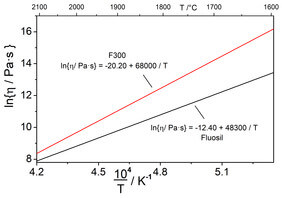- Home
- Research
- Fiber Research and Technology
- Research results
- The Viscous Behavior of Synthetic Silica Glass Tubes During Collapsing
The Viscous Behavior of Synthetic Silica Glass Tubes During Collapsing

23.04.2018
The viscous flow of pure and fluorine-doped silica tubes is studied by collapsing. The demonstrated method can be applied directly during MCVD preform preparation. By several experiments with different tube dimensions, both the material viscosity can be measured and information concerning the thermal behavior of the glass tubes during preform preparation and fiber drawing can be derived.
By: Sonja Unger // Johannes Kirchhof
Silica-based optical fibers for communication are produced by a two-step process. First, a “preform” with a core-cladding structure is fabricated, followed by the drawing of a light-guiding fiber from this preform. In the case of the widely-used modified chemical vapor deposition (MCVD) process, the preform is formed by the deposition of glassy films on the inside wall of a high-purity silica tube by gas phase reactions and the subsequent collapsing of the tube to a solid rod. The collapsing process is normally realized on the MCVD lathe, immediately after the layer deposition, by increasing the temperature and decreasing the velocity of the burner in comparison to the values during deposition. Under the influence of the surface tension of the glass tube and a certain impact pressure of the flames, the rotating tube is collapsed to a solid rod during one or a few burner passages with velocities between 1 and 5 cm·min-1. In preform/fiber fabrication, the viscosity behavior of the cladding and core glass plays an important role both in the process performance, economy, and fiber properties.
We have demonstrated that collapsing experiments can be successfully applied for the viscosity measurement of silica glass tubes in the high temperature region (i.e., for viscosity values between 107 Pa∙s and 104.5 Pa∙s). This method, described in [1], has the advantage of not requiring a crucible and, therefore, preventing the contamination of the glass melt, which is a serious problem at the high temperatures of silica glass processing. The method was theoretically established in detail and practically demonstrated using the example of two synthetic silica materials which are important for modern fiber technology. These tube materials are from Heraeus Quarzglas GmbH. We investigated both F300 as a highly-pure silica and Fluosil as a fluorine-doped material with a content of 3.4 wt% fluorine. F300 is the most important silica material for the current optical fiber technology in general, and Fluosil is gaining increasing importance in the field of modern specialty optical fibers, particularly for microstructured fiber waveguides and new fiber laser systems. The aim of this work was to demonstrate the principles of the method in detail and to determine both the true viscosity-temperature relationships and the thermal behavior of the tube materials under practical collapsing conditions.
For the exact determination of real viscosity values, a set of experiments with tubes of different wall thicknesses is necessary. Therefore, experiments were carried out with several tubes of an outer diameter between 8 mm and 33 mm, wall thicknesses between 0.6 mm and 6 mm and a uniform length of 500 mm, rotating on the MCVD lathe with an oxygen-hydrogen burner in the temperature range between 1600°C and 2100°C. During the process, the tube diameter, the inner tube pressure, the burner velocity and the width of the temperature profile have been measured. Based on this data, the values of the viscosity η at the temperature maximum of the axial profile were calculated using equations given in [1]. The calculated values show in the first instance a dependence on the wall thickness of the tubes. This phenomenon is due to the fact that the radiation loss in regions where the quartz glass is semitransparent (i.e., in a wavelength range between 2 μm and 4.5 μm) leads to a deviation between the measured temperature at the tube surface and the temperature inside the tube, the latter being responsible for the measured viscosity value. It could be shown that an extrapolation of these values to a wall thickness of zero is a well-suited procedure for derivation of correct viscosity-temperature relationships.
This approach leads to the following expressions:
F300: ln{η / Pa·s} = -20.20 + 68000 / T
Fluosil: ln{η / Pa·s} = -12.40 + 48300 / T
In both cases, the viscosity can be described by Arrhenius expressions in good approximation. Hence, the activation energy of the viscous flow can be calculated, resulting in 565 kJ∙mol-1 for F300 and 402 kJ∙mol-1 for Fluosil. Fluorine doping leads to a decrease in the activation energy and an increase in the pre-exponential factor. The interaction of both effects leads to a systematic decrease in the viscosity by about one order of magnitude at 1700°C. This is in general due to the weakening effect of fluorine on the glass network.
The dependence of the apparent viscosity behavior on the tube wall thickness can be used in order to estimate the difference between the temperature at the outer tube surface (i.e. the measured temperature) and the temperature at the inner tube surface (which is relevant for processes in the interior). In agreement with model calculations, we find small differences of about 20 K for tubes with a wall thickness of 1 mm. With increasing wall thickness this difference rises sharply up to values of about 200 K for a wall thickness of 6 mm. There is no remarkable difference between undoped and fluorine-doped silica tubes.
Even if the demonstrated method seems to be more difficult than classical methods of viscosity measurement, such as a rotating crucible and falling ball, it yields process-related data and, beyond that, valuable information on the temperature in the tube interior, which cannot be directly measured but is very important for preform and fiber technology.
Funded by: BMBF
